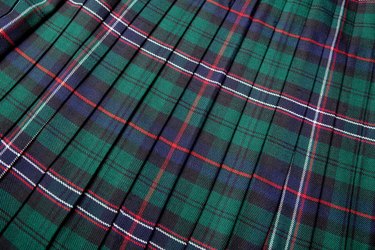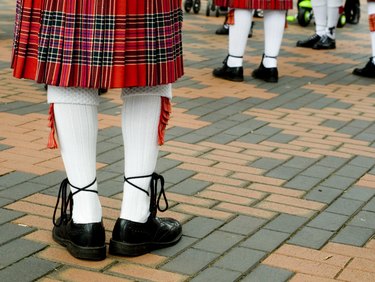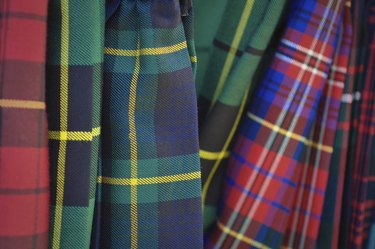
Most people are familiar with what we today call a "kilt." The garment, worn by men, looks like a skirt but is specialized to suit a male form. On a woman, a kilt is just another skirt, and fits like one. The term comes from the word "Celt," and over recent centuries has come to symbolize Scottish culture, along with the woolen tartan fabrics from which they are made.
Great Kilt
Video of the Day

The great kilt, or feileadh mór, is the traditional kilt worn throughout history until about the early eighteenth century. In Scots Gaelic the word "plaid" means "blanket," and the great kilt consists of a single piece of woolen plaid approximately three feet by six. The wearer lays the plaid on the ground, places his belt beneath it at a distance from the bottom equal to the desired length of the skirt part, makes pleats over the belt, then lies down and secures the belt around his waist. This leaves a large section of the plaid free when he stands, which he then gathers and throws over his shoulder. Sometimes this section is secured with a pin called a "brooch," but often it is simply left draped over the shoulder. An illustration of the feileadh mór can be found at the Eighteenth Century Patterns link below.
Video of the Day
Modern Kilt

The modern kilt, or "feileadh beg," was developed during the late 18th and early 19th centuries, when British royalty caught on to the idea of tartan as national identity. A modern kilt isn't quite so simple as the "feileadh mór," and most commercial patterns don't result in a proper kilt. To avoid ending up with an ordinary skirt, make certain your pattern is authentic. "The Art of Kiltmaking" at the link below is a good source for pointers on how to make a kilt. It's said there is no such thing as a "pattern" for a kilt, because the pleats should take into consideration the particular tartan being used. You simply take a piece of woolen plaid, unhemmed, pleat the back and leave the front flat. Belt loops can be sewn on, but they're not necessary. The garment should be long enough to come just above the knee, and wide enough to overlap the entire front, keeping in mind that traditionally kilts are worn without undergarments of any kind.
Setts

A "sett" is the pattern of colors and stripes in a given plaid. Certain patterns are said to be traditional to certain clans. This tradition goes back about 200 years, to the early 19th century when plaids and kilts came to symbolize Scotland, and by extension the individual clans. In the days of the "feileadh mór," the tartan colors and patterns were used for hunting camouflage.